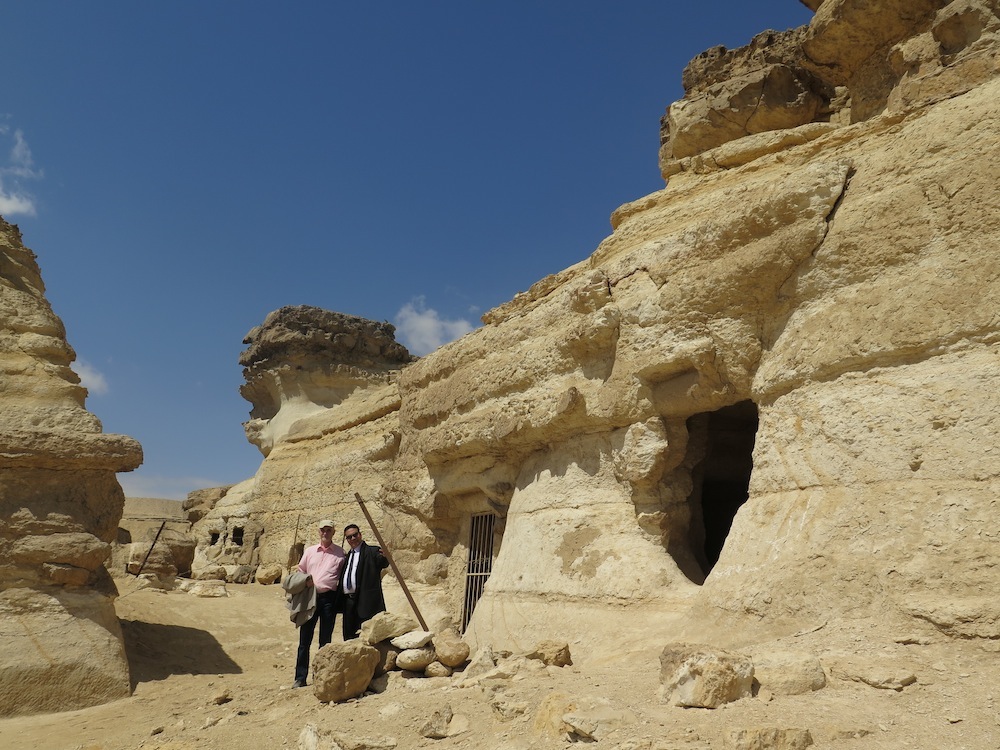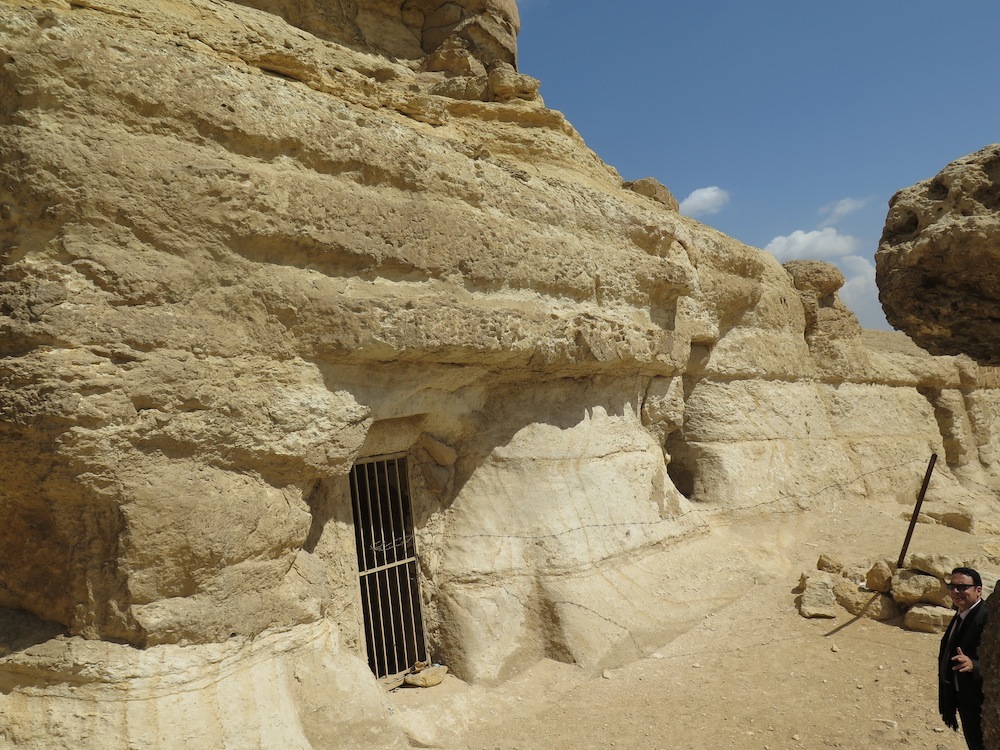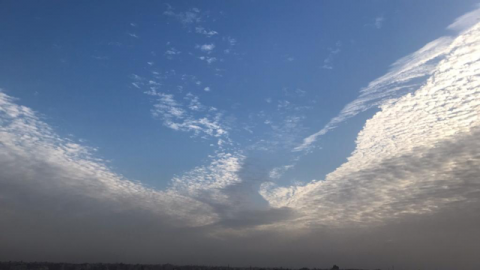A Second Sphinx at Giza Plateau?
by
Dr. Reda Abdel Halim
Does a Second Sphinx really exists at the Giza Pyramids area?
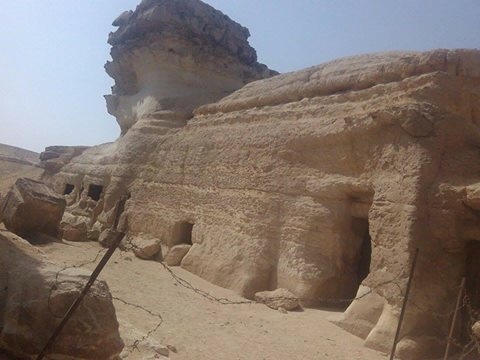 Shape of the “Second Sphinx. Southern wall (Photo – A.Wojcikiewicz)
Shape of the “Second Sphinx. Southern wall (Photo – A.Wojcikiewicz)
I was asking myself this question several times while visiting certain place at Giza Plateau looking at a formation of carved rocks situated about 250 meters from original… the First Sphinx (as I will call it here) near the Pyramid of Khafre (Chefren) and tombs of his sons. When you look at it at the distance, only one side of the shape that we call the “Second Sphinx” carved in the mother rock is visible. Therefore one can have impression that the Sphinx is “unfinished”. The second side is hidden or buried in the hardened sand or… in fact it is “unfinished” due to some events that took place at the times when the Sphinx was carved by ancient civilization. Its “head” is badly damaged by time but still one can notice similarities between the First and the “Second Sphinx”.
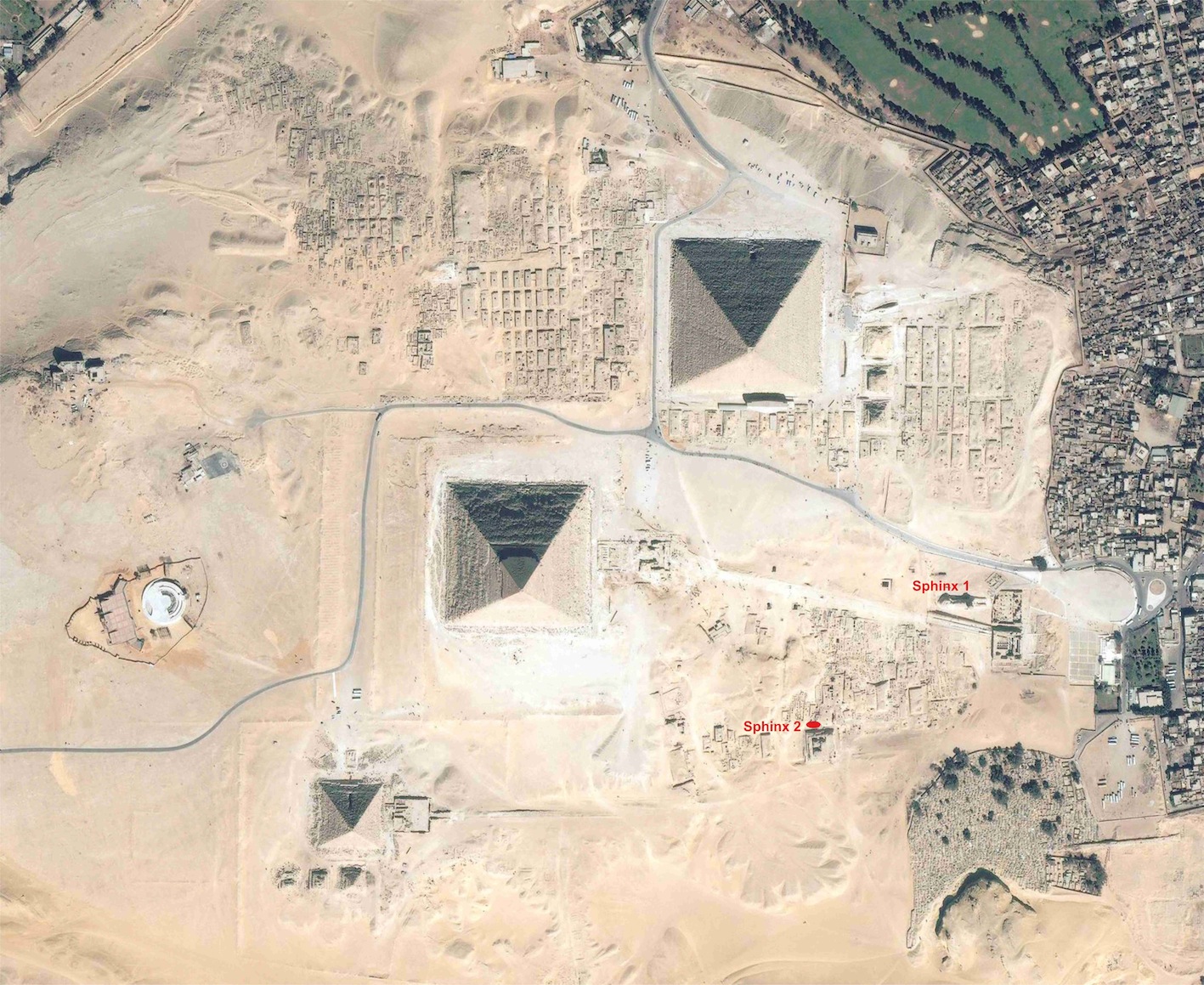 General location of both Sphinxes on Giza Plateau (marked in red)
General location of both Sphinxes on Giza Plateau (marked in red)
The symbol of Sphinx (as we all know) is a statue of a mythical creature of a lion with a human face carved in limestone. It is quite likely that Sphinx was originally coated with plaster and covered with paint. The effects of the original colors can still be seen on the First Sphinx near one ear.
Both Sphinxes are located on the west bank of the Giza Plateau. The First Sphinx is considered as the Guardian of the Plateau but… was there only one Guardian? The “Second Sphinx” is located in the southern area of the causeway leading to the Pyramid of King Khafra. On the north of the “Second Sphinx” one can see tombs of King Khafra’s children, and on the south tomb of Queen Khentkaus, wife of the king Khafra and mother of king Mykerinos.
Measurements of the Second Sphinx:
Both Sphinxes are the oldest known large sculptures carved in a mother-rock with a length of about 73.5 meters, from front paws to tails. The length of front legs of the Second Sphinx is 15-meters, and width of the whole body is 19.3 m measured on the surface (please, remember that “the other side” of the Second Sphinx is hidden). However after cleaning the area of the Second Sphinx the measures might be different. The measurement of about 20-meters could be estimated from the ground level to the top of the head.
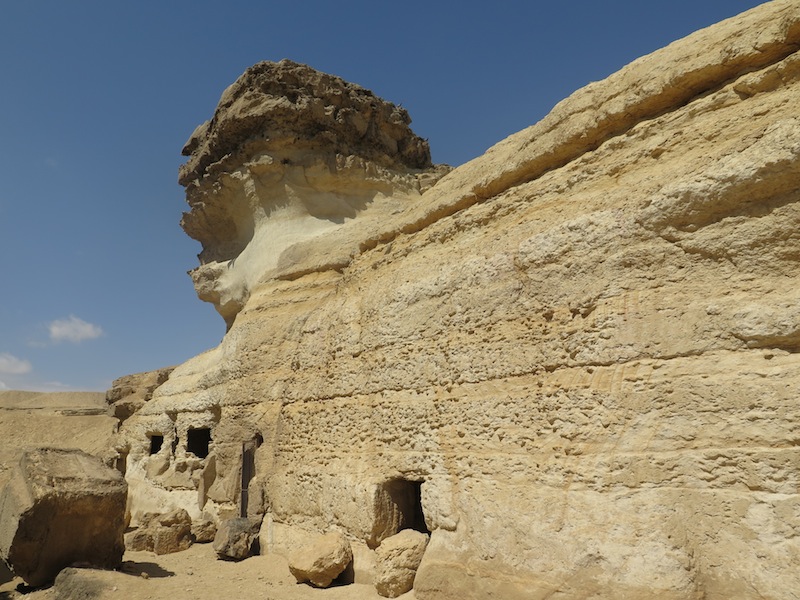 “Second Sphinx” – closer (Photo – A. Wojcikiewicz)
“Second Sphinx” – closer (Photo – A. Wojcikiewicz)
Egyptologists believe that ancient Egyptians had built both statues of Sphinx at the time of the pharaoh Khafra (the builder of the second pyramid in Giza), son of king Cheops, 2558 BC. Several scientists question this theory believing that priests have seen both statues long before the time of King Khafra and Sphinxes were build at earlier times. However it is not the age of Sphinxes I want to discuss here.
The statue of the First Sphinx is facing east. “Second Sphinx” statue is facing west. That could mean that both statues were symbolizing protection by the god RAA (RAA Hur Akhty) of the whole land of Egypt, and especially the Giza zone through looking in both directions – East and West.
Dr. Reda and dr. Adam Szynkiewicz by the “Second Sphinx” (Photo – A.Wojcikiewicz)
History of Sphinx research
Selim Hassan was the first Egyptian Egyptologist who researched in the area of the original Sphinx and wrote the first reference book about the excavations around it. He noticed that on the body of the First Sphinx there are many additional layers. These layers were mostly added in the Greco-Roman times about 306 BC to 284 BC.
French started initial research during Napoleon time when the Statue of the Sphinx was excavated. French Egyptologist, Mariette Pasha was the first one who found the entrance of the Sphinx at its back, after cleaning the area.
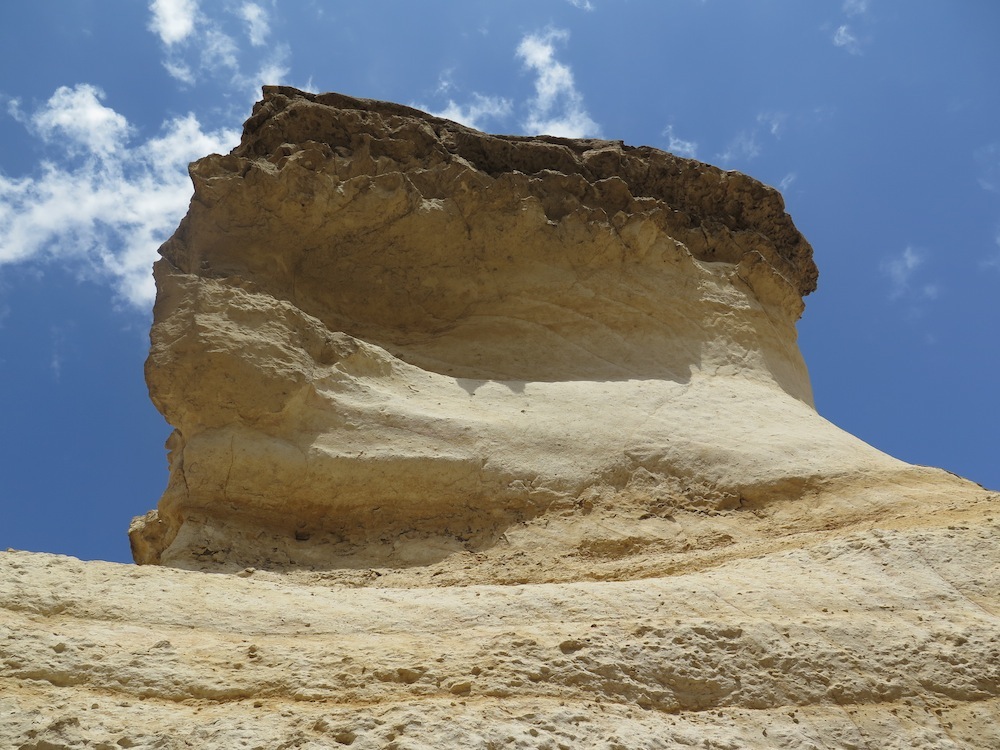 Badly damaged “head” of the “Second Sphinx” (Photo – A. Wojcikiewicz)
Badly damaged “head” of the “Second Sphinx” (Photo – A. Wojcikiewicz)
There are some striking similarities between both Sphinxes. The road from “Second Sphinx” also leads to the Second Pyramid of the king Khafra (Chefren). When we compare some measurements of the First and the visible parts of the Second Sphinx, there are striking similarities:
Second Sphinx First Sphinx
Total length: 71.50 m 73.5 meters
Length of legs: 15 m 20.0 meters
Height at the highest point of head: 20 m 20.0 meters
Please note, that measurements on the “Second Sphinx” were done with certain approximation since the degree of damage on the visible part of it is quite high. With respect to outer casing of the “Second Sphinx” we have found remains of stones in the form of a wall or clothing to body rock of the Sphinx at a distance of approximately 5 meters away from the body.
The shape of the “Second Sphinx” was done in the single block of limestone as it could be seen in the First Sphinx. However some researchers believe that the Sphinx-like shape represents just remains of a quarry that was used to cut limestone for the construction of tombs situated around the “Second Sphinx” and therefore a formation of the “Second Sphinx” is purely coincidental and has no connection with the original Sphinx. But is this really “coincidental”?
After research and study of the nature of this rock it was concluded that the “Second Sphinx” is very much like the original Sphinx statue. Also, Selim Hassan has found and cleaned the big Stella made from the red granite on which one could see two Sphinxes looking in different directions carved on its top. It is called a “dream Stella”. This Stella came from the time of king Thotmos Forth (XVIII Dynasty, New Kingdom) and it could suggest that that in ancient time the Second Sphinx really existed.
In my research I started to describe and to measure the body of southern holes that could have been side doors leading into the body of the mother rock of the “Second Sphinx”. I found (10) holes in the body of this formation.
I would like to mention that I shared my observations with the Pennsylvania University Mission working under the supervision of famous Archaeologist, dr. Mark Lehner who was cleaning the area of Queen Khentkawes tomb (very near to “Second Sphinx”) during the season 1996-1998. At later time I decided to protect some of these 10 holes of the southern side of the “Second Sphinx” by adding iron doors to some entrances in order to protect them from further devastation.
These ten openings (holes) can be descripted as follows:
The hole number one (1)
Starting from the east to the west – it is about 1.65 meters in height and about 80 cm wide.
The hole number two (2)
Closed by an iron door but one can see what is inside. Further research shows that there are two holes in the wall and the second hole inside in the right wall and as well as a dark tunnel filled with sand.
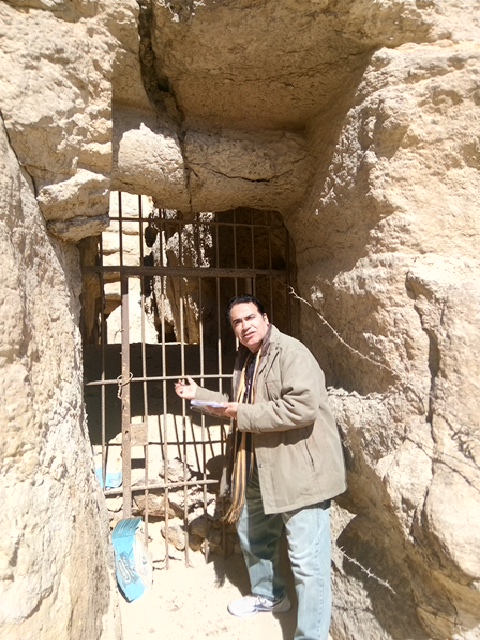 Dr. Reda by the hole Nr 2 (Photo – Reda Abdel Haleem)
Dr. Reda by the hole Nr 2 (Photo – Reda Abdel Haleem)
The hole number three (3)
It takes the random shape closer to an oval shape.
The hole number four (4)
Two iron doors are installed: one in front and the other on the other side.
The hole number five (5)
The pit is characterized by a clear crack in the body of the statue from the top of the body of the rock.
The hole number six (6)
By looking inside it became clear to me that there is a long room with a side door to the east side of the wall of the room to the right of the interior.
The hole number seven (7)
It is without an iron door like other holes with quantities of sand mixed with fine ash and pieces the stones that fill the place. Obviously it requires cleaning.
The hole number eight (8)
It had an empty door. It is clear that there is a well inside close to the wall opposite to the inside of its door which is perpendicular to the front of the neck that carries the head of the statue. It is covered with stones lining to cover cracks and openings. It looks like the Eastern Sphinx was known for a long time.
The hole number nine (9)
It has a large door with internal corridors and a side corridor in the shape of an internal well located to the right of the interior of the room that is close to the bottom of the head of the statue.
Iron door to the hole Nr 9 (Photo – A.Wojcikiewicz)
The hole number ten (10)
It has a sloping corridor with side hole that take random forms like one of the holes. This hole is located directly below the head of the statue.
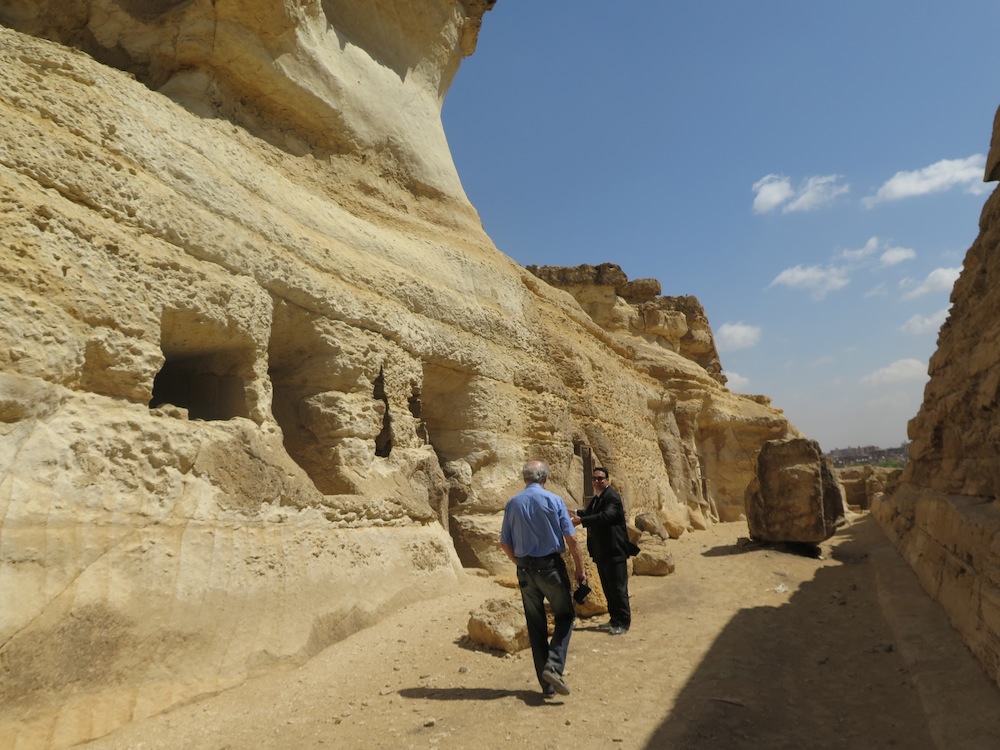 Holes in the “Second Sphinx” (Photo – A.Szynkiewicz)
Holes in the “Second Sphinx” (Photo – A.Szynkiewicz)
I had offered my research of “Second Sphinx” study the to the professors and community of Archaeologists during the 2016 Conference at the University of Zagazig and this great community had accepted my research to be published in their scientific magazines in Egypt and Iraq. Obviously – some further research is needed in order to find out more about this fascinating subject and perhaps some Egyptian or international archaeological Mission can be created in order to find out more about this site.
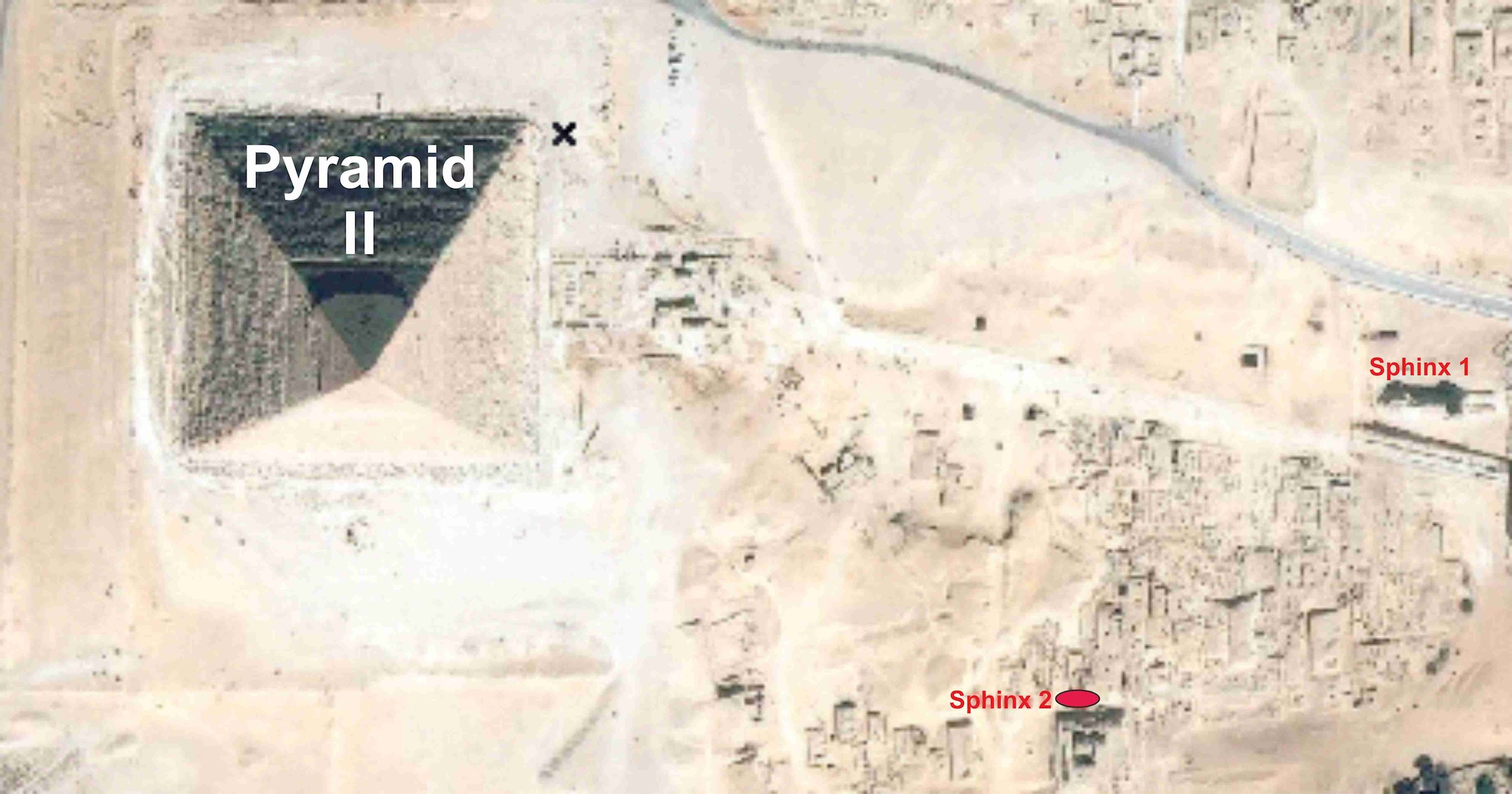 More precise location of both Sphinxes (marked red)
More precise location of both Sphinxes (marked red)
Final questions
Questions to be answered are the following:
* Is the shape of the rock that we call “Second Sphinx” coincidental rock formation or theory of the Second Sphinx has its scientific merit?
* Is the Second Sphinx just an “unfinished” carving in mother rock, where only half of the body is carved and other half was for some reason abandoned?
* Was there some cataclysmic event in the past that stopped building the Second Sphinx or caused its extensive damage?
* Is “the other side” of the Second Sphinx just a rock, or hardened sand that can be removed in order to reveal its full body?
* Are there any underground chambers, tunnels or shafts under the “Second Sphinx”?
A ground penetrating radar (GPR) research, cleaning the area and uncovering the covered side of the “Second Sphinx” as well as research the stones where the shape is carved could easily answer these questions.
Dr. Reda Abdel Halim, Egyptologist and archaeologist, works as General Director for Public Relations at Giza Pyramids area. He specializes in mud-brick pyramids and Greco-Roman period in the history of Egypt. In 2008-2009 he worked as on-site manager at Hawara Necropolis research conducted by Egyptian-Polish archaeological mission based on the agreement between the University of Cairo and the University of Wroclaw, Poland. He is the Member of Council of Polish Foundation for the Support of Research to Disclose Ancient and Modern Knowledge “Wisdom of Nations”

